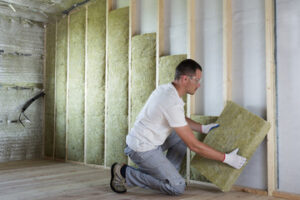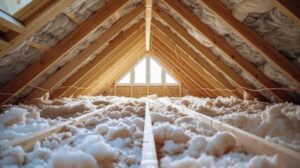Insulation is crucial for regulating the temperature of your home. Old or damaged insulation may cause high energy bills and a less comfortable living environment.

Old insulation also traps dust, allergens and pollutants that will harm air quality. Insulation Removal Perth will allow for new, clean insulation to be installed.
The right preparations will ensure a smooth insulation removal process. Here are some things to consider before getting started.
Insulation removal can be a very costly project depending on the level of contamination and infestation that is involved. Additionally, there may be significant prep work that needs to be done to ensure that the next step in the process is successful – insulation replacement. This type of project is best left to professionals who will not only be able to do the job quickly and efficiently but will also make sure that the replacement materials are properly installed to provide lasting protection against moisture, rodents, pollutants and pests.
The average cost of removing insulation from the attic is around $900 for a typical 600 square foot attic space. This doesn’t include other associated costs like disposal or new insulation installation.
Blown-in insulation, which fills every nook and cranny in the attic space, is usually more difficult to remove than fiberglass batts or rolls. This is because it takes much longer to get the blowing machine set up and running, and it can be very hot and uncomfortable working in attics. Additionally, it can be a challenge to locate and clean all of the junction boxes and wires in the attic, which can add to the overall cost of the project.
It is important to determine why you are considering insulation removal before jumping into the process. Often times, simply adding more insulation to the existing setup is a more effective and less expensive solution. Other reasons for insulation removal can include mold, pests and rodents, air quality issues and high energy bills.
The first step in the process is to inspect and prepare the attic for the removal. This is generally a very messy and dirty job, so it is important to have a professional on hand who can clean up and protect the rest of the house. Additionally, it is important to test the attic for asbestos before starting, as asbestos insulation is more dangerous than fiberglass.
After the attic is cleaned, the insulation can be removed by machine or by hand. The machine method is faster and more efficient, but it will still require a significant amount of labor. Hand removal is slower but will also result in a higher cost due to the time it takes to bag and dispose of all of the insulation.
Health & Safety
Insulation removal requires a lot of work and adherence to strict safety measures. The process involves handling a variety of materials, including asbestos, which poses health risks. Therefore, it is best left to professionals who are trained in environmental hazard removal. Professionals are also equipped with the necessary tools and equipment to carry out the task efficiently. This includes protective gear and ventilation systems, which ensures a safe working environment. They can also identify potential environmental hazards, and implement appropriate containment measures.
It is essential to prepare the work area before beginning the insulation removal process. This includes sealing off the work area, preparing tools, and making sure that all supplies are in place. Moreover, identifying the type of insulation is crucial as it will help you plan your removal strategy effectively. Moreover, it will allow you to minimize the impact on the building occupants. It will also help you avoid the risk of contaminating the surrounding areas.
Before starting the process, make sure that you have all the necessary supplies and equipment, such as a high-powered vacuum cleaner, safety gear, and garbage bags. It is also advisable to have a tarp to place underneath the bags as you fill them. This will facilitate easy clean-up and ensure that all contaminants are kept in one bag, minimizing the risk of contamination. Additionally, you should wear a respirator mask to protect yourself from airborne dust and particles.
Insulation is a valuable home improvement project that can improve your home’s energy efficiency and reduce your utility bills. It can also help you improve your indoor air quality by trapping odors and reducing allergens. It is important to note, however, that certain types of insulation can be damaged by water leaks or pests.
If not removed promptly, these damaged insulation materials may cause mold or other environmental hazards in your home. They can also affect the structural integrity of your home and lead to significant damage in the long run. To prevent these issues, it is important to remove old and damaged insulation before laying new ones.
Environmental Impact
Insulation removal is a complex and dangerous process that requires professional equipment. Professionals use high-powered vacuums with HEPA filters to remove old insulation and keep harmful particles from escaping into the air. They also follow strict protocols for handling hazardous materials and adhere to disposal regulations. This protects the health and safety of those involved in the removal process as well as the surrounding environment.
Old insulation can contain a variety of harmful contaminants that can pose serious health risks, including mold and rodent droppings. Often, these contaminates are invisible to the naked eye. They can cause respiratory problems and other issues, and lead to a decline in indoor air quality. In addition, old insulation is often a breeding ground for pests. Removing and replacing old insulation can help to eliminate pest infestations, promoting a safer and more comfortable living environment.
One of the primary reasons why people seek out insulation removal services is to address air quality issues in their home. This can be caused by a number of factors, including water damage and poor ventilation. If not addressed promptly, these issues can saturate the insulation, rendering it ineffective and leading to mold growth. In addition, leaks can allow water to seep into the building’s structure and corrode its components. In these situations, insulation removal is necessary to restore the integrity of the building and improve its energy efficiency.
In addition to improving indoor air quality, insulation can help to reduce energy costs by preventing heat and cold loss. It can also provide noise reduction and increase comfort levels in a home. However, it’s important to consider the specific needs of a home before deciding on the best type of insulation for it.
When choosing a professional to handle the installation of new insulation, look for a company that is licensed and insured. They should have a solid reputation and extensive experience in the field. In addition, they should be able to answer any questions you might have about the process. They should also be willing to discuss your specific needs and provide a detailed quote for the project.
Time
The amount of time needed to complete the process will vary based on the type of insulation, attic size and whether you choose to take on the project yourself or hire professionals. It is best to plan ahead for this project by getting the proper equipment and supplies before you begin. In order to remove blown in cellulose or fiberglass insulation, it is important to have a commercial vacuum with enough hoses and connectors to reach from the attic to outside for disposal. You will also need a rake, dustpan and sturdy waste bags for disposal. It is recommended to wear protective clothing when handling the insulation, including gloves, respirator and eye protection. You will also want to consider cleaning up the tools, equipment and surfaces inside your home before beginning the process.
Cellulose insulation will need to be taken to a recycling center that accepts it and is not a landfill. If you are unsure of where to dispose of it, you may want to contact your local government for more information.
Fiberglass and rolled insulation can be recycled locally as well and can be used in various projects that need a sustainable, eco-friendly product. Both types of insulation will continue to perform as long as they are not exposed to moisture, mold or rodents, which can cause them to lose their R-value. If the insulation has been compromised by pests, it is important to have it removed and replaced with newer, higher R-value insulation to prevent costly damage.
Old insulation can also reduce the energy efficiency of your home, leading to higher utility bills. Replacing it with newer insulation can help reduce energy costs and make your home more comfortable. It can be difficult to tell if your insulation needs to be replaced, as it is often not visible from the ground level. However, signs of deterioration include visible settling or shifting, moisture in the attic, high utility bills and an unpleasant odor.
One less invasive and expensive option for replacing your old insulation is spray foam insulation. This is a great alternative to tearing down walls, and can be installed in just a day.
